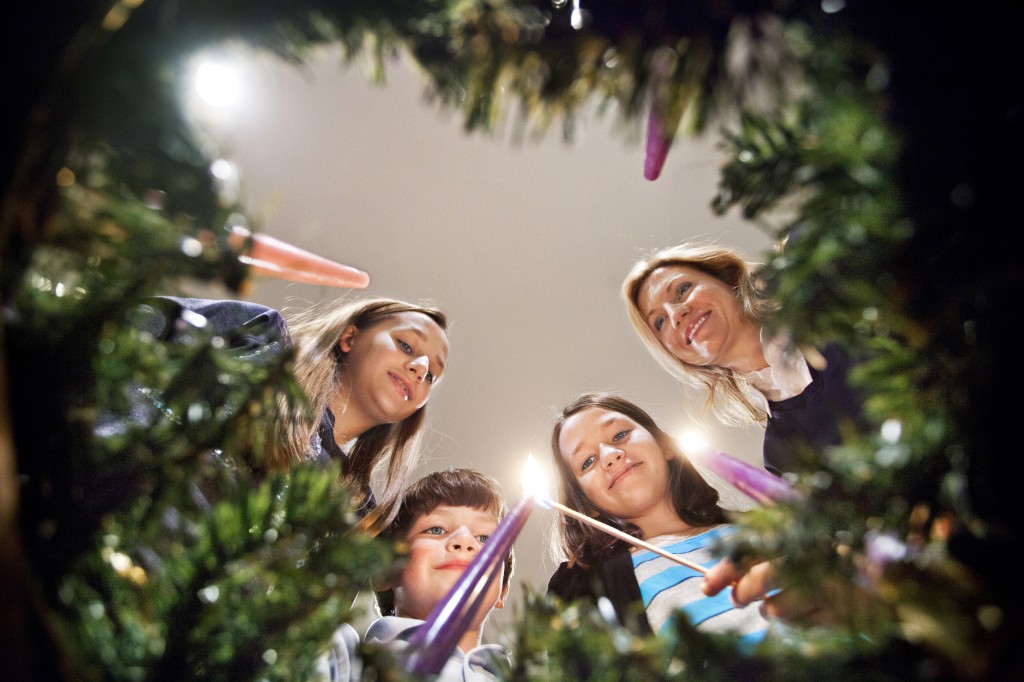

In joyful expectation, Catholics throughout the world wonder, wait and prepare for the coming of the Lord during the four weeks of Advent.
Advent means, “arrival,” and the four weeks before Christmas are a time of preparation and waiting on two levels: in celebration of the birth of Jesus, and for His second coming in glory.
During Advent, which begins on Sunday, Dec. 1, Catholics are challenged to refrain from secular demands and distractions by creating an atmosphere of holiness in honor of the holy event.
The four weeks are meant to give time to prepare for the mystery of the Incarnation.
The Catechism of the Catholic Church says, “When the Church celebrates the liturgy of Advent each year, she makes present this ancient expectancy of the Messiah, for by sharing in the long preparation for the Savior’s first coming, the faithful renew their ardent desire for His second coming. By celebrating the precursor’s birth and martyrdom, the Church unites herself to His desire: ‘He must increase, but I must decrease.’ ” (§524)
Even though the season tends to be filled with gifts, parties and Christmas music, Fr. Matt Lowry, chaplain at Holy Trinity Catholic Newman Center in Flagstaff and associate vocations director for the Diocese of Phoenix, said Catholics should consider how they can beautify their soul around the manger of the Lord.
“Where there is external preparation and celebration, we need to spend more time with our internal preparation and celebration of what God is doing in our lives,” Fr. Lowry said.
“It can really be a new beginning, a re-encounter with God who chose to come down in the mess of our lives and be part of it all.”
The liturgy, the heartbeat of the Church, is celebration.
Each time the faithful gather for liturgy they celebrate an event, a happening in the long history of God’s relationship with people down through the ages.
Liturgy is the unfolding of the story of salvation through, with and in Jesus. The liturgical year, also known as the “Church Year,” celebrates these cycles of events in the life of Christ.
The first Sunday in Advent is the “New Year” for the Church. Just as the calendar year follows the sun, the liturgical year follows the life of the Son.
“As we near major feasts like Christmas and Easter in our liturgical cycle, we always have a preparation period,” said Tricia Hoyt, director of Evangelization, Family Ministry and Adult Formation at St. Patrick Parish in Scottsdale.
Hoyt said one way to prepare for Advent during the “frantic, jingled Christmas noise,” is through the sacrament of reconciliation.
“It’s a beautiful sacrament to help us enter into Advent. We reflect and ask ourselves how are we doing as a bearer of Christ,” she said.
“We prune ourselves of habits that don’t serve the people of God, and ask for healing.”
One European tradition that helps remind Catholics to prepare homes and hearts for the celebration of the coming of Jesus is the use of an Advent wreath.
The circle of evergreen, a sign of everlasting life, is a reminder that God’s love is never ending. There are four candles that signify the four Sundays of Advent.
Culturally, Catholics are accustomed to thinking of Advent as a preparation for the birth of Jesus, but there is a different emphasis liturgically.
The birth of the Messiah is focused on the fourth Sunday of Advent.
The first Sunday is a reminder of the coming of Christ at the end of time, while the second and third Sundays focus on the acceptance of Christ, through baptism.
“Advent is a time of expectation where God reveals. It’s a time of hope,” said Fr. Lowry. “At World Youth Day this summer, Pope Francis said we should expect surprises from our God. We need to look for Christ to come, and expect bigger things than we can imagine.”
Advent is followed by the Christmas season. Technically, the Octave of Christmas is from Christmas to the Solemnity of Mary on Jan. 1, or traditionally from Christmas through Jan. 5.
Liturgically speaking, the Christmas season lasts until the Feast of the Baptism of the Lord, and it’s filled with rich traditions and wonderful feasts.
The five major feasts of the Christmas season are: the Solemnity of the Nativity of the Lord; the Feast of the Holy Family of Jesus, Mary, and Joseph; the Solemnity of Mary, the Holy Mother of God; the Solemnity of the Epiphany of the Lord; and the Feast of the Baptism of the Lord.
Family Christmas customs range vastly, but by putting the season into its proper place in the calendar, the month reveals additional ways to adore and welcome Emmanuel, “God is with us.”
For Joel and Bridget Dickinson, keeping their focus on Christ is a priority for their two young sons.
The St. Thomas the Apostle parishioners start with the feast of St. Andrew, Nov. 30, to gear up for the season of Advent and beyond.
Each year they like to add another small “nugget” of their faith into their Christmas celebrations.
Last year the family experienced “hearts of gratitude” when they delivered presents to families in need.
“It was powerful,” Bridget said. “The boys saw how they are being Christ for others, which is what we are called to do every day of the year.”






